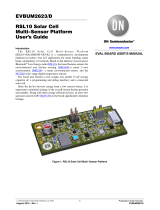Page is loading ...

ADXL355 Accelerometer PMOD
Demo
The ADuCM360_demo_adxl355_pmdz is an accelerometer demo project for the EVAL-
ADICUP360 base board with the EVAL-ADXL355-PMDZ board, using the GNU ARM Eclipse
Plug-ins in Eclipse environment.
General description
This project is an example for how to use EVAL-ADICUP360 board in combination with
the EVAL-ADXL355-PMDZ accelerometer PMOD board.
The ADuCM360_demo_adxl355_pmdz project uses the EVAL-ADXL355-PMDZ which has
the ADXL355 3-axis MEMS accelerometer on board.
The application reads the X , Y , and Z acceleration registers. The acceleration in the 3 axis is
displayed in [G]. There is an internal temperature sensor in the ADXL355, which is converted by
the on chip 12-bit ADC. The acceleration range can also be selected by setting
the ADXL355_RANGE variable with the ADXL355.h file. (Values of [2, 4, and 8 are acceptable] )
All the outputs are printed from the UART to the USER USB port and can be read on the PC
using a serial terminal program, such as Putty or Tera Term.
For precision applications, each ADXL355 chip requires individual calibration which can be done
by measuring and setting the
definitions ACC_TEMP_BIAS and ACC_TEMP_SENSITIVITY parameters in the ADXL362.h file.
The temperature in degrees celsius, can be derived from the ADC readings Tadc using the
predefined formula:

Temp = (Tadc - ADXL355_TEMP_BIAS)/ ADXL355_TEMP_SLOPE) + 25;
Setting up the hardware
To program the base board, set the jumpers as shown in the next figure. The
important jumpers are highlighted in red.
Plug the EVAL-ADXL355-PMDZ board in the EVAL-ADICUP360 base board, via the
PMOD_SPI port (P4).
Power EVAL-ADICUP360 base board via the Debug USB.(If programmed, switch to
the USER USB for serial terminal display)
Obtaining the source code
We recommend not opening the project directly, but rather import it into Eclipse and make a local
copy in your Eclipse workspace.
To learn how to import the ADuCM360_demo_adxl355_pmdz project form the projects
examples in the Git repository, please click on How to import existing projects from the GIT
Repository.
The source code and include files of the ADuCM360_demo_pmodacl2 can be found on Github:

AduCM360_demo_adxl355_pmdz at Github
Importing the
ADuCM360_demo_adxl355_pmdz project
The necessary instructions on how to import ADuCM360_demo_adxl355_pmdz project in your
workspace can be found in the section, Import a project into workspace.
Debugging the
ADuCM360_demo_adxl355_pmdz project
A debug configuration must be set up for this project in order to have the possibility to
program and to debug the ADuCM360_demo_adxl355_pmdz project. To do this,
follow the instructions from Setting up a Debug Configuration Page.
Make sure the target board is connected to the computer (via DEBUG USB) and
using the tool bar, navigate to the small Debug icon and select the debugging
session you created. The application will programmed and the program execution will
stop at the beginning of the main() function.

Use step-by-step execution or directly run the program.
After completion of the steps above the program will remain written into the system flash and it
will run by default every time the board is powered up.
Project structure
The ADuCM360_demo_adxl355_pmdz project use basic ARM Cortex-M C/C++ Project
structure. This project contains: system initialization part - disabling watchdog, setting system
clock, enabling clock for peripheral; port configuration for SPI0, accelerometer sensor
use; SPI read/write functions; sensor monitoring.

In the src and include folders you will find the source and header files related to ADXL355
application. You can modify as you wanted those files. The Communication.c/h files
contain SPI and UART specific data, meanwhile the ADXL355.c/h files contain the accelerometer
data. Here are parameters you can configure:
Temperature sensor calibration values-
ADXL355_TEMP_BIAS and ADXL355_TEMP_SLOPE paramaters - find your values
based on the calculation formula (ADXL355.h ):
#define ADXL355_TEMP_BIAS (float)1852.0

#define ADXL355_TEMP_SLOPE (float)-9.05
Accelerometer range setting - ADXL_RANGE parameter - 2, 4, or 8 are acceptable
values to set the [g] range for the ADXL355 (ADXL355.h).
#define ADXL_SENSE 2
Sensor activity and inactivity thresholds -
ACT_VALUE and INACT_VALUE paramaters used to determine at which
acceleration values the sensor can react at sleep/wake-up commands (ADXL355.h):
#define ACT_VALUE 50
#define INACT_VALUE 50
Sensor activity and inactivity time - ACT_TIMER and INACT_TIMER paramaters
used to determine sleep/wake-up intervals(ADXL355.h):
#define ACT_TIMER 50
#define INACT_TIMER 50
The system folder contains system related files (try not to change these files):
ADuCM360 – contains low levels drivers for ADuCM360 microcontroller.
CMSIS – contains files related to ADuCM360 platform, such
as: ADuCM360.h (registers definitions), system_ADuCM360.c/h (system
clock), vectors_ADuCM360.c (interrupt vector table).
cortexm – contains files for system management (start-up, reset, exception handler).
/






